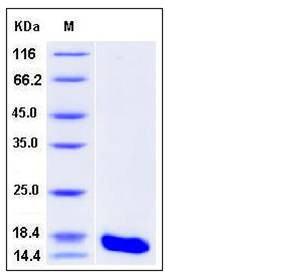Human Cystatin S / CST4 Protein (His Tag)
CST4,MGC71923
- 100ug (NPP3790) Please inquiry
| Catalog Number | P11542-H08H |
|---|---|
| Organism Species | Human |
| Host | Human Cells |
| Synonyms | CST4,MGC71923 |
| Molecular Weight | The secreted recombinant human CST4 consists of 132 amino acids and migrates as an approximately 16 kDa band in SDS-PAGE under reducing conditions as predicted. |
| predicted N | Ser 21 |
| SDS-PAGE |  |
| Purity | > 98 % as determined by SDS-PAGE |
| Protein Construction | A DNA sequence encoding the human CST4 (NP_001890.1) (Met 1-Ala 141) was fused with a polyhistidine tag at the C-terminus. |
| Bio-activity | |
| Research Area | |
| Formulation | Lyophilized from sterile PBS, pH 7.4 1. Normally 5 % - 8 % trehalose, mannitol and 0.01% Tween80 are added as protectants before lyophilization. Specific concentrations are included in the hardcopy of COA. |
| Background | Cystatin-S, also known as Cystatin-4, Salivary acidic protein 1, Cystatin-SA-III and CST4, is a secreted protein which belongs to the cystatin family. Cystatin-4 / CST4 is expressed in submandibular and sublingual saliva but not in parotid saliva (at protein level). It is also expressed in saliva, tears, urine and seminal fluid. The cystatin superfamily encompasses proteins that contain multiple cystatin-like sequences. Some of the members are active cysteine protease inhibitors, while others have lost or perhaps never acquired this inhibitory activity. There are three inhibitory families in the superfamily, including the type 1 cystatins (stefins), type 2 cystatins and the kininogens. The type 2 cystatin proteins are a class of cysteine proteinase inhibitors found in a variety of human fluids and secretions. Cystatin-4 / CST4 strongly inhibits papain and ficin, partially inhibits stem bromelain and bovine cathepsin C, but does not inhibit porcine cathepsin B or clostripain. Papain is inhibited non-competitively. Cystatin-4 / CST4 is an S-type cystatin, based on its high level of expression in saliva, tears and seminal plasma. The specific role in these fluids is unclear but antibacterial and antiviral activity is present, consistent with a protective function. |
| Reference |
